Basic-zipper-type transcription factor FlbB controls asexual development in Aspergillus nidulans
- PMID: 17993569
- PMCID: PMC2224158
- DOI: 10.1128/EC.00207-07
Basic-zipper-type transcription factor FlbB controls asexual development in Aspergillus nidulans
Abstract
The fungal colony is a complex multicellular unit consisting of various cell types and functions. Asexual spore formation (conidiation) is integrated through sensory and regulatory elements into the general morphogenetic plan, in which the activation of the transcription factor BrlA is the first determining step. A number of early regulatory elements acting upstream of BrlA (fluG and flbA-E) have been identified, but their functional relations remain to be further investigated. In this report we describe FlbB as a putative basic-zipper-type transcription factor restricted to filamentous fungi. FlbB accumulates at the hyphal apex during early vegetative growth but is later found in apical nuclei, suggesting that an activating modification triggers nuclear import. Moreover, proper temporal and quantitative expression of FlbB is a prerequisite for brlA transcription, and misscheduled overexpression inhibits conidiation. We also present evidence that FlbB activation results in the production of a second diffusible signal, acting downstream from the FluG factor, to induce conidiation.
Figures
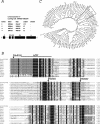
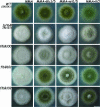
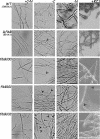
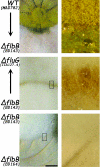

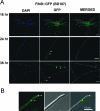


Similar articles
-
Tip-to-nucleus migration dynamics of the asexual development regulator FlbB in vegetative cells.Mol Microbiol. 2015 Nov;98(4):607-24. doi: 10.1111/mmi.13156. Epub 2015 Sep 4. Mol Microbiol. 2015. PMID: 26256571
-
Aspergillus nidulans FlbE is an upstream developmental activator of conidiation functionally associated with the putative transcription factor FlbB.Mol Microbiol. 2009 Jan;71(1):172-84. doi: 10.1111/j.1365-2958.2008.06520.x. Epub 2008 Nov 5. Mol Microbiol. 2009. PMID: 19007409
-
Rite of passage: a bZIP transcription factor must transit the cell apex to become competent.Mol Microbiol. 2015 Nov;98(4):605-6. doi: 10.1111/mmi.13224. Epub 2015 Oct 20. Mol Microbiol. 2015. PMID: 26387769
-
Aspergillus nidulans asexual development: making the most of cellular modules.Trends Microbiol. 2010 Dec;18(12):569-76. doi: 10.1016/j.tim.2010.09.007. Epub 2010 Oct 28. Trends Microbiol. 2010. PMID: 21035346 Review.
-
Apical control of conidiation in Aspergillus nidulans.Curr Genet. 2016 May;62(2):371-7. doi: 10.1007/s00294-015-0556-0. Epub 2016 Jan 18. Curr Genet. 2016. PMID: 26782172 Review.
Cited by
-
GmcA is a putative glucose-methanol-choline oxidoreductase required for the induction of asexual development in Aspergillus nidulans.PLoS One. 2012;7(7):e40292. doi: 10.1371/journal.pone.0040292. Epub 2012 Jul 5. PLoS One. 2012. PMID: 22792266 Free PMC article.
-
Homeobox transcription factor HbxA influences expression of over one thousand genes in the model fungus Aspergillus nidulans.PLoS One. 2023 Jul 21;18(7):e0286271. doi: 10.1371/journal.pone.0286271. eCollection 2023. PLoS One. 2023. PMID: 37478074 Free PMC article.
-
The social network: deciphering fungal language.Nat Rev Microbiol. 2011 Jun;9(6):440-51. doi: 10.1038/nrmicro2580. Nat Rev Microbiol. 2011. PMID: 21572459 Review.
-
Development in Aspergillus.Stud Mycol. 2013 Mar 15;74(1):1-29. doi: 10.3114/sim0006. Epub 2012 Sep 14. Stud Mycol. 2013. PMID: 23450714 Free PMC article.
-
Role of the blue light receptor gene Icwc-1 in mycelium growth and fruiting body formation of Isaria cicadae.Front Microbiol. 2023 Jan 10;13:1038034. doi: 10.3389/fmicb.2022.1038034. eCollection 2022. Front Microbiol. 2023. PMID: 36704565 Free PMC article.
References
-
- Adams, T. H., M. T. Boylan, and W. E. Timberlake. 1988. brlA is necessary and sufficient to direct conidiophore development in Aspergillus nidulans. Cell 54353-362. - PubMed
-
- Aguirre, J. 1993. Spatial and temporal controls of the Aspergillus brlA developmental regulatory gene. Mol. Microbiol. 8211-218. - PubMed
-
- Aguirre, J., R. Ortiz, J. Clutterbuck, R. Tapia, and M. Cardenas. 1993. vegA and cfwA define two new developmental genes in Aspergillus nidulans. Fungal Genet. Newsl. 40A:68.
-
- Aguirre, J., M. Rios-Momberg, D. Hewitt, and W. Hansberg. 2005. Reactive oxygen species and development in microbial eukaryotes. Trends Microbiol. 13111-118. - PubMed
Publication types
MeSH terms
Substances
LinkOut - more resources
Full Text Sources
Other Literature Sources
Molecular Biology Databases
Miscellaneous

